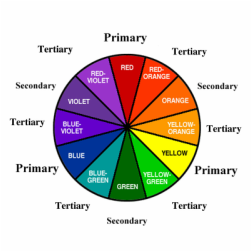 You probably already know this, but just in case: the primary colors are red, blue, and yellow. They cannot be created by mixing colors. It is from these colors, however, that all other colors have their origin. When you mix two primary colors you arrive at a secondary color. Red and blue makes purple, red and yellow makes orange, and blue and yellow makes green. Once you mix three colors together, such as orange, orange, and yellow, you get a tertiary color. Which tertiary color you get will depend on which primary colors you combine and in which proportion. Many people consider black and white to be colors, but they’re not. You can’t make black or white by mixing other colors together. These are considered hues or shades. When you add black to a color, you darken that color; conversely, when you add white, you lighten the original color. Colors also have a tendency to be either warm or cool. Reds and yellows, as a general rule, are considered warmer colors. Blues, on the other hand, are considered cooler colors. While there are different types of primary colors, you will always get a secondary color when mixing two primary colors together. To help you determine what colors you will receive when combining a particular set of paints, you may want to create a color wheel or chart. Begin with a triangle on a sheet of paper. At each point paint one of the primary colors from your set. In the middle of those two colors, on each side of the triangle, mix equal amounts of the primary colors to make the secondary color. Keeping track of which primary colors you’re using when creating a new color is helpful. You’ll want to list which colors you began with and then in which proportions so you’ll be able to duplicate the color in the future. Look at the colors opposite of each other on your color wheel; those are called complementary colors. So, the complementary color for red is green, blue is orange, and yellow is purple. Why do you need to know about color theory and how will it help you as a crafter or artist? Knowing what colors are needed to create other colors can help when painting, using colored pencils, or deciding which colors to combine for your home décor. Now, what can you do with this new knowledge? We offer a variety of fun and interesting art classes at JC Arts Council. Contact us today, or check out our home page for more info.
0 Comments
Leave a Reply. |
 RSS Feed
RSS Feed
